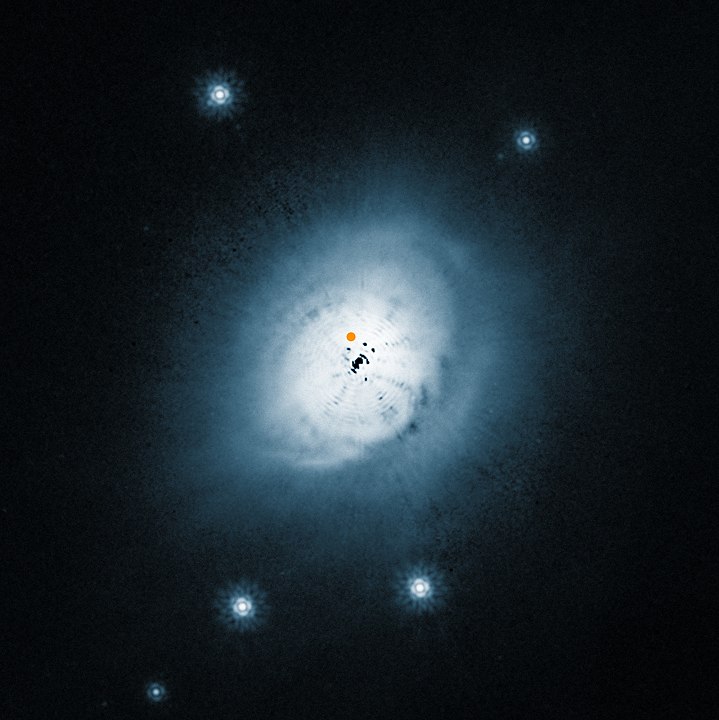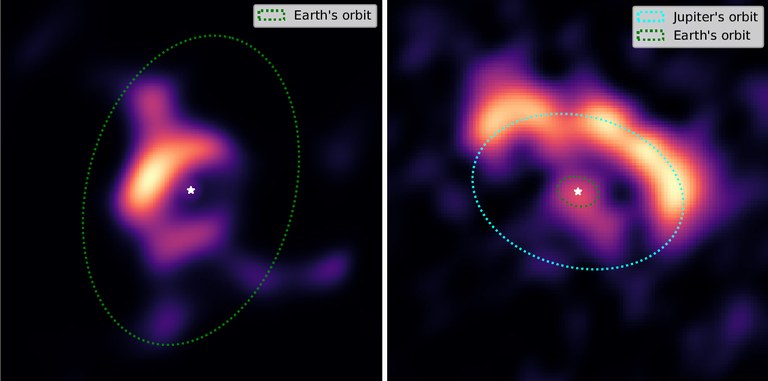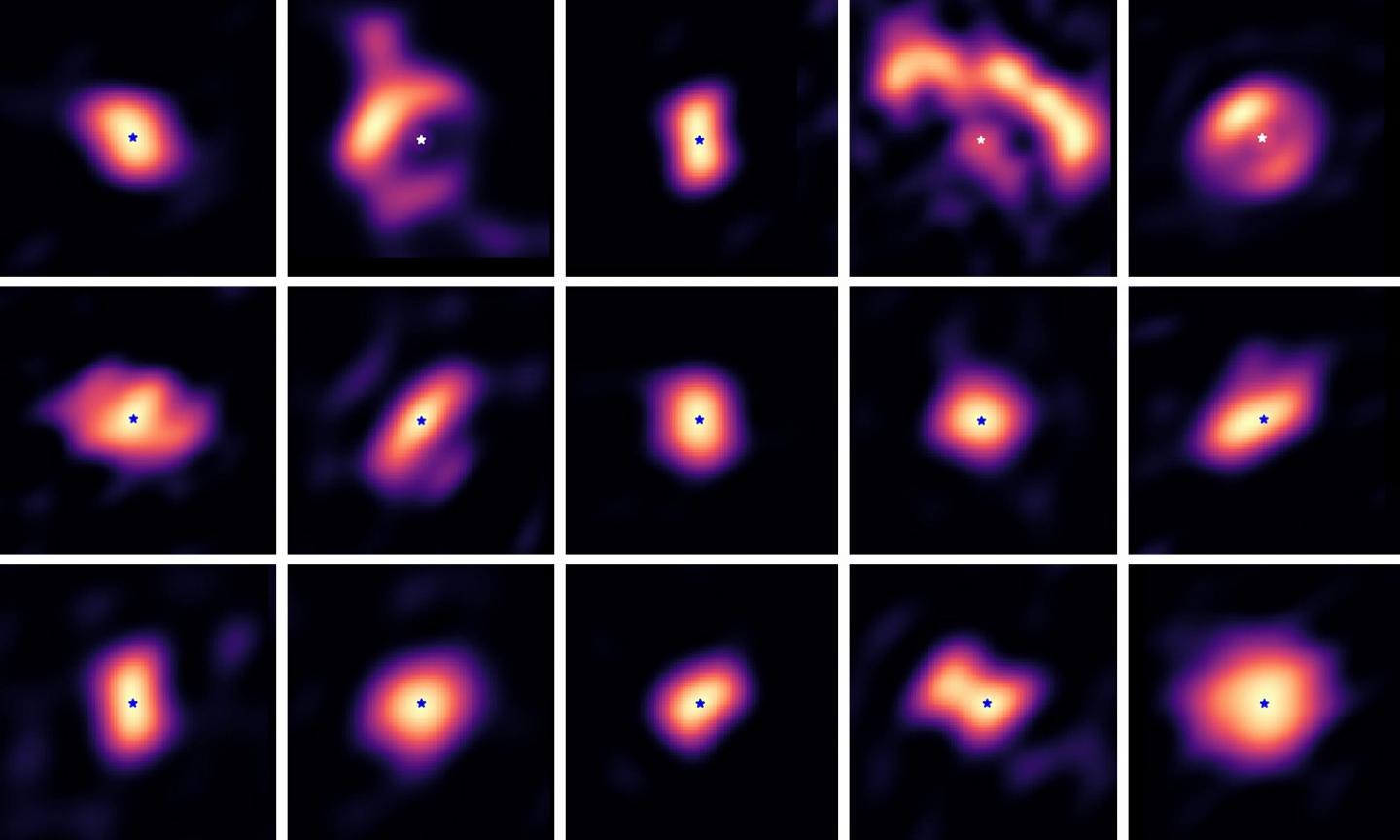Astronomy is advancing to the point where we can see planets forming around young stars. This was an unthinkable development only a few years ago. In fact, it was only two years ago that astronomers captured the first image of a newly-forming planet.
Now there are more and more studies into how planets form, including a new one with fifteen images of planet-forming disks around young stars.
This new study is titled “A family portrait of disk inner rims around Herbig Ae/Be stars.” The lead author is Jacques Kluska from KU Leuven in Belgium. The new study is published in the journal Astronomy and Astrophysics. Herbig Ae/Be stars are young, pre-main sequence stars.
Our “nebular hypothesis” explains how stars and planets form. In a nutshell, it starts with a molecular cloud, an accumulation of mostly hydrogen. Eventually some of the material in the cloud begins to clump togethere. Like a snowball, the clump grows over time, and revolves. As it becomes more massive, its gravity draws more material in.

At some point so much material has clumped together that a star forms and fusion ignites. (There’s a lot more detail than this brief explanation contains, but it gets the main point across.)
But the star doesn’t use all the material in the original molecular cloud. The remaining material forms a disk around the now-rotating star, called a protoplanetary disk. The disk rotates too, and material in the disk begins to clump together, to form young planets.

That’s a brief working description of how planets form around stars.
The problem for astronomy has been seeing into those dusty disks to see the young planets. At first, astronomers contented themselves with observing growing gaps in the disks, indicating that a planet was forming and sweeping up all the gas and dust in its lane. And even that was difficult.
But studies like this new one are giving astronomers—and the rest of us—a glimpse into the planet-formation that goes inside the shroud of gas and dust.
“These inner regions are … of fundamental importance because they are the place where most of the planets are believed to form in or migrate to.”
From the Paper “A family portrait of disk inner rims around Herbig Ae/Be stars” by Kluska et al 2020.
Understanding what goes on inside the disk when planets form is critical to our overall understanding of planets and exoplanets. The authors write that “…the initial conditions for planet formation are indeed determined by the disk properties, its dust and gas densities, its composition, structure, and dynamics.”
And once a planet forms, it can then influence how any other planets might form. “Once formed, the planets in turn influence the disk structure, potentially causing gaps, warps, and a variety of features that were revealed by millimeter-interferometry and scattered-light imaging.”
The problem with prior studies of these inner regions is that “…observing techniques cannot access the morphologies of the inner disk regions (located within 5 au around the central star) as they cannot reach a sufficiently high angular resolving power,” they write.

They also strengthen the case for studying these inner-disk regions, writing “These inner regions are nonetheless of fundamental importance because they are the place where most of the planets are believed to form in or migrate to.”
The study presents 15 images of of planet-forming disks hundreds of light years away. The authors of the study focused on the inner rims of these disks, because that’s where rocky planets like Earth are most likely to form. Surveys of exoplanets also show a large number of planets inhabiting that region around their host stars.

Prior to this study, astronomers had captured images of protoplanetary disks, but those images couldn’t reveal a lot of detail. “In these pictures, the regions close to the star, where rocky planets form, are covered by only few pixels,” said lead author Jacques Kluska in a press release.
The team behind this study developed a new process for imaging the inner rims of these disks.
“We needed to visualize these details to be able to identify patterns that might betray planet formation and to characterize the properties of the disks. I’m thrilled that we now for the first time have fifteen of these images,” Kluska continued.
The team relied on the PIONIER instrument at the European Southern Observatory in Chile. PIONIER is part of the Very Large Telescope Interferometer (VLTI), which combines the light from four telescopes at once.

Interferometry is a powerful tool, and the VLT is a powerful telescope; one of the world’s premier astronomical facilities. But this combination of technique and technology still didn’t produce actual images of the young planets. Getting the images required more work: an innovative mathematical reconstruction technique.
It’s similar to how the Event Horizon Telescope got the first image of a black hole. “We had to remove the light of the star, as it hindered the level of detail we could see in the disks”, Kluska explains.
“Distinguishing details at the scale of the orbits of rocky planets like Earth or Jupiter (as you can see in the images) — a fraction of the Earth-Sun distance — is equivalent to being able to see a human on the Moon, or to distinguish a hair at a 10 km distance,” notes Jean-Philippe Berger of the Université Grenoble-Alpes, who as principal investigator was in charge of the work with the PIONIER instrument. “Infrared interferometry is becoming routinely used to uncover the tiniest details of astronomical objects. Combining this technique with advanced mathematics finally allows us to turn the results of these observations into images.”

We’re really only in the beginning of trying to understand planet-formation processes. There must be an enormous amount of granular detail and variability, so much that it might be difficult to call it a single process. This study turned up some of that detail and variability.
“You can see that some spots are brighter or less bright, like in the images above: this hints at processes that can lead to planet formation,” said Kluska. “For example: there could be instabilities in the disk that can lead to vortices where the disk accumulates grains of space dust that can grow and evolve into a planet.”
The team behind this study intends to keep working. They intend to research the irregularities they found in these rings, and to probe for even more detail. One of the goals is to directly witness planet formation in the closest regions to the star. They’ve also begun to study a set of 11 older stars and their disks of dust and gas, as planets may form there, too.

